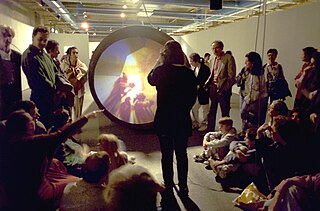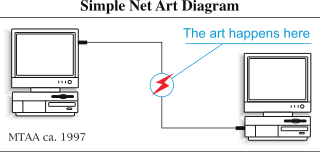
Interactive art is a form of art that involves the spectator in a way that allows the art to achieve its purpose. Some interactive art installations achieve this by letting the observer walk through, over or around them; others ask the artist or the spectators to become part of the artwork in some way.

Wolfgang Tillmans is a German photographer. His diverse body of work is distinguished by observation of his surroundings and an ongoing investigation of the photographic medium’s foundations.

Electronic art is a form of art that makes use of electronic media. More broadly, it refers to technology and/or electronic media. It is related to information art, new media art, video art, digital art, interactive art, internet art, and electronic music. It is considered an outgrowth of conceptual art and systems art.

Alexei Shulgin is a Russian born contemporary artist, musician, and online curator. Working out of Moscow and Helsinki, Shulgin established the Immediate Photography Group in 1988 and started his career in this area of study. After 1990, he shifted his interests from photography to the Internet, and consequently, in 1994, founded Moscow-WWW-Art-Lab WWW Art Lab, collaborating with many artists from London and Slovenia. That very same year, the artist created an online photo museum called "Hot Pictures". In 1997, Shulgin continued with the invention of Form Art, and later that year the introduction of the Easy Life website. In 1999, Shulgin became Webmaster at FUFME, Inc. Since 2004, Shulgin has been a co-owner of Electroboutique.

Jan Saudek is an art photographer and painter.

Virtual art is a term for the virtualization of art, made with the technical media developed at the end of the 1980s. These include human-machine interfaces such as visualization casks, stereoscopic spectacles and screens, digital painting and sculpture, generators of three-dimensional sound, data gloves, data clothes, position sensors, tactile and power feed-back systems, etc. As virtual art covers such a wide array of mediums it is a catch-all term for specific focuses within it. Much contemporary art has become, in Frank Popper's terms, virtualized.
Mark Napier is an early adopter of the web and a pioneer of digital and Internet art (net.art) in the United States, known for creating interactive online artwork that challenges traditional definitions of art. He uses code as an expressive form, and the Internet as his exhibition space and laboratory. Napier developed his first web-based applications for financial data in 1996. He is the author of his own website,potatoland.org, his online studio where many of his net artworks can be found, such as Shredder 1.0, net.flag, Riot, etc.

Casey Edwin Barker Reas, also known as C. E. B. Reas or Casey Reas, is an American artist whose conceptual, procedural and minimal artworks explore ideas through the contemporary lens of software. Reas is perhaps best known for having created, with Ben Fry, the Processing programming language.

Shu Lea Cheang is a Taiwanese-American artist and filmmaker who lived and worked in New York City in the 1980s and 90s, until relocating to Europe in 2000. Cheang received a BA in history from the National Taiwan University in 1976 and an MA in Cinema Studies from New York University in 1979. Since the 1980s, as a multimedia and new-media artist, she has navigated topics of ethnic stereotyping, sexual politics, and institutional oppression with her radical experimentations in digital realms. She drafts sci-fi narratives in her film scenario and artwork imagination, crafting her own “science” fiction genre of new queer cinema. From homesteading cyberspace in the 1990s to her current retreat to post net-crash BioNet zone, Cheang takes on viral love, bio hack in her current cycle of works.
Wolfgang Staehle is an early pioneer of net.art in the United States, known for his video streaming of the collapse of the World Trade Center in New York City during the September 11 attacks. He also captured the crash of the first plane into the World Trade Center.
John Klima is an American new media artist, who uses hand-built electronics, computer hardware and software to create online and in gallery artworks.
Christiane Paul is chief curator/director of the Sheila C. Johnson Design Center at Parsons School of Design and Professor of Media Studies at The New School, and Adjunct Curator of New Media Arts at the Whitney Museum of American Art in New York City. She is the author of the book Digital Art, part of the 'World of Art' series published by Thames & Hudson.

Internet art is a form of new media art distributed via the Internet. This form of art circumvents the traditional dominance of the physical gallery and museum system. In many cases, the viewer is drawn into some kind of interaction with the work of art. Artists working in this manner are sometimes referred to as net artists.

Eva & Franco Mattes are a duo of artists based in New York City. Operating under the pseudonym 0100101110101101.org, they are counted among the pioneers of the Net Art movement and are known for their subversion of public media. They produce art involving the ethical and political issues arising from the inception of the Internet. They are based in Brooklyn, New York, but also travel frequently throughout Europe and the United States.
Juergen Nogai is a German architecture, art and documentary photographer.

New media art includes artworks designed and produced by means of electronic media technologies, comprising virtual art, computer graphics, computer animation, digital art, interactive art, sound art, Internet art, video games, robotics, 3D printing, and cyborg art. The term defines itself by the thereby created artwork, which differentiates itself from that deriving from conventional visual arts. New Media art has origins in the worlds of science, art, and performance. Some common themes found in new media art include databases, political and social activism, Afrofuturism, feminism, and identity, a ubiquitous theme found throughout is the incorporation of new technology into the work. The emphasis on medium is a defining feature of much contemporary art and many art schools and major universities now offer majors in "New Genres" or "New Media" and a growing number of graduate programs have emerged internationally. New media art may involve degrees of interaction between artwork and observer or between the artist and the public, as is the case in performance art. Yet, as several theorists and curators have noted, such forms of interaction, social exchange, participation, and transformation do not distinguish new media art but rather serve as a common ground that has parallels in other strands of contemporary art practice. Such insights emphasize the forms of cultural practice that arise concurrently with emerging technological platforms, and question the focus on technological media per se. New Media art involves complex curation and preservation practices that make collecting, installing, and exhibiting the works harder than most other mediums. Many cultural centers and museums have been established to cater to the advanced needs of new media art.
Thomas Rusch is a German photographer living in Berlin, Hamburg and Paris.
Monica Bonvicini is a German-Italian artist. In her work, Bonvicini investigates the relationship between power structures, gender and space. She works intermediately with installation, sculpture, video, photography and drawing mediums.
Media art history is an interdisciplinary field of research that explores the current developments as well as the history and genealogy of new media art, digital art, and electronic art. On the one hand, media art histories addresses the contemporary interplay of art, technology, and science. On the other, it aims to reveal the historical relationships and aspects of the ‘afterlife’ in new media art by means of a historical comparative approach. This strand of research encompasses questions of the history of media and perception, of so-called archetypes, as well as those of iconography and the history of ideas. Moreover, one of the main agendas of media art histories is to point out the role of digital technologies for contemporary, post-industrial societies and to counteract the marginalization of according art practices and art objects: ″Digital technology has fundamentally changed the way art is made. Over the last forty years, media art has become a significant part of our networked information society. Although there are well-attended international festivals, collaborative research projects, exhibitions and database documentation resources, media art research is still marginal in universities, museums and archives. It remains largely under-resourced in our core cultural institutions.″

Wolfgang Weber was a German photojournalist and film producer.












